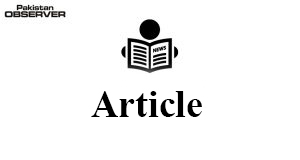M Nauman Hafeez Khan
THE analysis of the economic history of Pakistan portrays a gloomy picture in terms of its financial planning and performance among the South Asian countries. The economic predicament of Pakistan started just after its independence when the Indian government refused to give the due share of Pakistan from the divided pool. The successive years after the independence saw constitutional and political crisis that overshadowed the need of a strong economic reconstruction of the country. Though Quaid timely analysed the need of a monetary setup in Pakistan and inaugurated the State Bank of Pakistan on 1st July 1948, the later leadership ignored the much needed structural reforms in the economic sector. The cumbersome economic structure of Pakistan has been supported by foreign aids and external loans that bought momentary relief to the ailing economy. But these periods were short lived and the bust cycles that followed these periods largely affected social and infrastructural development in Pakistan. During these periods, corruption and missing accountability in the public sector remained a buzzword for the country’s leadership to shy away from sustainable economic reforms. Out of twenty two International Monetary Fund’s programmes, only two have been successfully completed, this shows how the financial authorities of Pakistan failed to put the economy in the right direction.
The current economic crisis of Pakistan needs strong leadership and strategic management. While plotting the future trajectory of structural reforms in economic sector, lessons from the past must be recalled. Firstly, the chronic issue of import-export gap and sliding foreign exchange reserves resulted from the import dependent commodity sector of Pakistan. While neighbouring countries like China, India and Bangladesh devalued their currencies at purpose to keep the imports down, Pakistan overvalued its currency from 1990 to 2018. This resulted into “Dutch Disease” which switched the commodity sector to the use of imported goods. The capital flight continued for almost two decades leading to crippled industrial sector and larger trade gap. Secondly, the Gordian knot of the circular debt remained unchecked since the independent power producers were introduced in the country. The power sector is still missing any sustainable policy reform to cope with this situation. The cosmetic reforms introduced in the power sector in the late nineties and early years of the new century brought no significant changes in the debt situation. Resultantly, the active circular debt has swelled to a gigantic sum of Rs860 billion. Thirdly, the State Owned Enterprise (SOEs) in Pakistan are a point source of financial bleeding. A large chunk of the budget is allocated to subsidise these SOEs to keep them operational. For public sector economic reforms, it is inevitable to eliminate these subsidies to shrink the budget deficit. Yet, without any policy based initiatives to revamp SEOs, these subsidies will remain the main part of the fiscal expenditure in the budget.
Pakistan, since the early years, has ignored the importance of Human Development Index (HDI) in the economic progress of a country. According to current status, Pakistan stands 150 out of 189 in human development index. The deafening silence by the government on the human development in Pakistan is worrying. Good HDI standing in the economic development is as important as the GDP is. Pakistan is blessed with a large population of youth below thirty years of age. This youth is capable of steering the country in the right direction. Hurdles in the ease of doing business and the absence of entrepreneurial environment in Pakistan is causing the youth to find employment opportunities in foreign countries. The current government has significantly improved the ease of doing business in Pakistan by reaching a historical milestone. Resultantly, the ranking of Pakistan in ease of doing business improved from 138 to 108. Yet, there is a long way to attract foreign direct investment in Pakistan that would enhance the employment opportunities for youth. Without any iota of doubt, both the State Bank and the Ministry of Finance need to play an active role in the formulation and implementation of monetary and financial policies respectively. The State Bank needs regular checks and balances on the over devaluation of the rupee. The timely shift to the market determined dollar rate is a welcome move by the State Bank, sill there is a need to strictly regularise the exchange of dollar with the local currency. Moreover, collective efforts by all state agencies are needed to fight Money Laundering and Financing of Terrorism. There is a significant progress by the government in rolling back the grey listing of Pakistan by the Financial Action Task Force (FATF), still there is a large room for improvement in the AML/CFT regime. Pakistan needs to learn from its past mistakes in the financial sector to move ahead. There are lessons to learn from the glaring examples of China, India and Bangladesh and their efforts to improve the economy. Strong strategic and structural economic planning coupled with the lessons from the history is the need of the time for Pakistan to emerge out successfully from the economic maze.
—The writer is Islamabad based freelance columnist.










